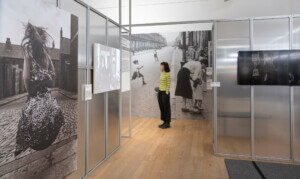Most New Yorkers know Housing Works though cheerfully crammed thrift stores where vintage blazers, crystal candy dishes, and nice books can be had for good prices. Yet the storefronts are infrastructure for a larger mission: As its name suggests, Housing Works provides housing and social services to homeless New Yorkers living with HIV and AIDS. A new project by a Columbia curator teases many stories out of the documents stretching back to its founding in 1990, when the city had few of supportive housing for an estimated 13,000 homeless citizens with HIV/AIDS.
Housing Works History is a meticulous digital archive that covers the organization from its founding 27 years ago to its work today in a multimedia timeline that’s as elegant as it is thorough. Timed to the 30th anniversary of ACT UP (AIDS Coalition to Unleash Power), the grassroots group and Housing Works precursor that formed in response to government inaction around HIV/AIDS, Housing Works History speaks to the past and future of supportive housing in New York for the most marginalized groups.
That housing, and the activism that made it happen, shaped the city subtly but profoundly. “Focusing on physical spaces gave me a way in, a way to talk about the history, the stories, and the different voices from those spaces,” said Gavin Browning, the curator behind Housing Works History. Drawing on his academic background in urban planning and his work at Columbia University (he’s the director of public programs and engagement at Columbia University School of the Arts, and the inaugural director of Studio-X), Browning’s project provides a forum for a distinctly New York story.
Inspired by oral history and the Howard Zinn–esque bottom-up approach to historiography, Housing Works History sorts each significant event, program, or housing milestone chronologically along with links to important court rulings, scanned newspaper clippings, photographs, video, and other ephemera, grounded by parallel timelines of diagnosis and infection rates.
The juxtaposed timelines, Browning said, help connect data to lived experience to “expose an archive that wasn’t being seen or used, or really acknowledged. Most people don’t know this history, and how it’s connected to the development of the city. It’s really essential New York City history.”
A click on the year 2000 brings viewers, via archival footage, to the Housing Works Gay Pride parade float, and to the organization’s stewardship of two brownstones on West 130th Street, a project started by community group Stand Up Harlem. The project is a platform for collective voices that have shaped the organization and the movement it foregrounds, as well as a window into how a social movement shaped architecture and design in New York.
Long abandoned, those brownstones were transformed into supportive housing for substance users. Designed by architect Benjamin Kracauer, the Stand Up Harlem House opened in 2008 and provides 16 units for single adults and families affected by HIV/AIDS. The design connects two adjacent brownstones but moves entryways to the garden level, providing streetscape continuity while allowing for greater accessibility.
In addition to the timeline, Browning collaborated with Laura Hanna to shoot five original films featuring the architects, activists, and Housing Works employees behind five of the organization’s housing projects. In one, Browning interviews, roundtable-style, a Stand Up Harlem resident, Desi Glazier, program director Ivan Gonzales, a Housing Works attorney, and Kracauer. For the spatially-inclined, there’s a map, too, that organizes the group’s projects and significant sites.
Housing Works History, Browning said, was influenced by Group Material’s 1989 installation, AIDS Timeline, which used media, artifacts, and ephemera to document AIDS’s evolution from its roots as a health issue to one that shaped LGBT and dominant culture. Close to home, the project grew from a 2012 project Browning curated with Karen Kubey in New York. Living Room: Housing Works Builds Housing explored the group’s activism and advocacy that led to the construction of 170 units in three neighborhoods for its target population. Despite his work, Browning isn’t employed by for Housing Works; he obtained project funding from the Graham Foundation.
Though the website officially debuts today, Housing Works History‘s official launch party is next week at the New York Pubic Library’s main branch (details here). Browning sees the project as a “stepping stone” for other’s work—he hopes, for example, the work could inspire others’ academic research or ground perspectives on today’s struggles for equity and visibility.










